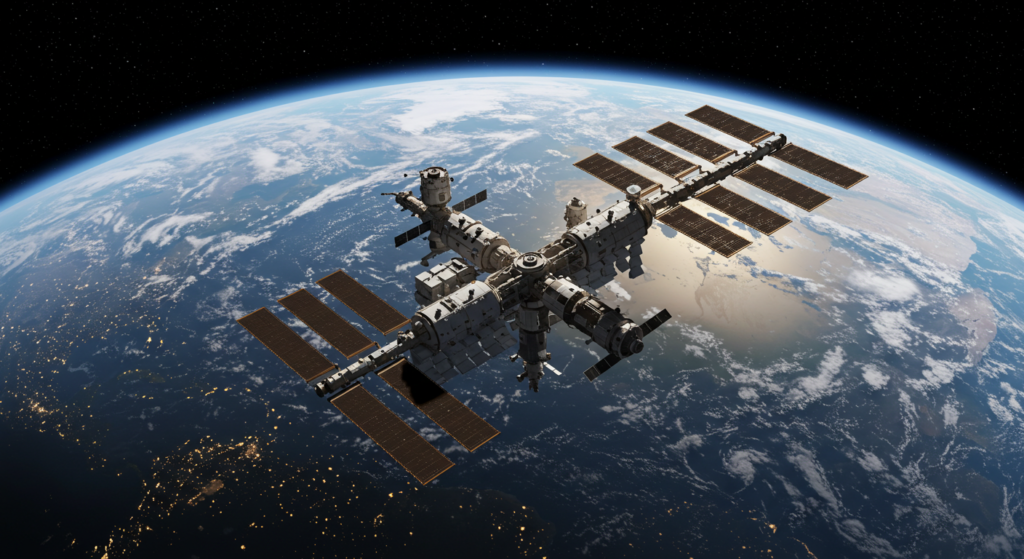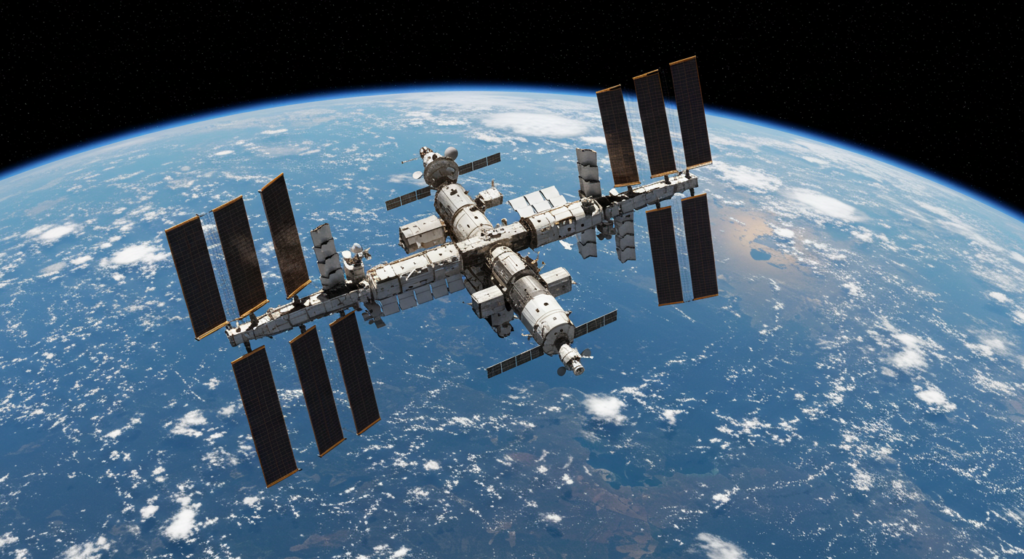The International Space Station (ISS) represents a monumental achievement in human collaboration and scientific exploration. This unique structure orbits Earth, serving as a hub for international research and education. As such, it not only facilitates scientific discovery but also fosters a sense of global community among participating nations.
The ISS not only serves as a platform for scientific research but also plays a crucial role in inspiring future generations to engage in STEM fields and fostering international collaboration.
The ISS stands as a testament to the power of international collaboration, showcasing how nations can unite for a common purpose in the pursuit of knowledge and exploration. This article delves into the fascinating history and development of the ISS, highlighting the key partnerships that have shaped its existence. From its inception to its current role as a hub for scientific research, we will explore how the ISS not only advances our understanding of space but also inspires future generations to engage in STEM fields. Join us as we uncover the remarkable journey of the ISS and its impact on global cooperation in space exploration.
As we embark on this journey through the history and significance of the ISS, it’s hard not to feel wonder. Imagine the countless hours of teamwork, late-night brainstorming, and shared dreams of astronauts floating in microgravity. Whether you’re a space enthusiast or just curious about how we can come together to achieve the extraordinary, this exploration of the ISS will not only enlighten you about its scientific contributions but also inspire you to think about how collaboration can lead to groundbreaking achievements in our own lives. So, grab your space helmet and get ready to dive into the incredible story of the International Space Station—where science meets unity, and the sky is not the limit!
Discover How the International Space Station (ISS) Became a Beacon of Hope for Global Partnerships
What drove the creation of the Space Station project, officially approved by President Reagan in 1984? This initiative aimed to foster international collaboration among partners from Canada, Japan, and various European nations. The ISS is not just a marvel of engineering; it’s a testament to what we can achieve when we put our minds together. The vision was to create a shared platform for scientific inquiry that transcended national boundaries and united diverse cultures in pursuit of knowledge.
The project sought to unite efforts in space exploration and scientific research.
The Space Station project received significant backing from President Reagan, who recognized its potential for international cooperation. NASA Administrator James Beggs played a crucial role in seeking global partners for this ambitious endeavor. Thus, Canada, Japan, and several European countries joined forces to contribute to the construction and operation of the ISS. This collaboration exemplifies how nations can come together to achieve extraordinary feats that would be impossible alone. Imagine a world where countries set aside their differences to reach for the stars—literally!
Similarly, the collaboration with international partners enhanced the safety and efficiency of space missions. The ISS is designed to accommodate new modules, facilitating the integration of advanced technologies as they become available. This adaptability ensures that the ISS remains at the forefront of scientific research and technological innovation.
Another key point is the historical context of the ISS’s development. The initial phase involved collaboration with the Russian Mir space station, which provided valuable insights into long-duration space missions. These insights have been instrumental in shaping the future of human spaceflight and ensuring the safety of astronauts on extended missions. It showcases the benefits of global partnerships in addressing complex challenges in human physiology and materials science. Through these partnerships, researchers can tackle problems that require diverse expertise and perspectives, leading to more comprehensive solutions.
Therefore, the ISS stands as a symbol of what humanity can achieve through collaboration and shared goals.
The Untold Story of the International Space Station’s Design
In the late 1980s, a vision emerged that would change humanity’s relationship with space forever. The design and construction of the International Space Station (ISS) began, uniting multiple countries in a groundbreaking endeavor. This ambitious project aimed to create a platform for scientific research and international collaboration. By bringing together the best minds from around the world, the ISS serves as a beacon of hope for future scientific endeavors.
The design phase of the Station spanned from 1984 to 1993, with construction of its elements starting in the late 1980s across multiple countries. This period marked a significant shift in how nations approached space exploration. It represented a collective realization that collaboration could yield greater results than isolated efforts.
Each country contributed unique technologies and expertise, enhancing the overall project. It’s like a cosmic potluck, where each nation brings its best dish to the table of exploration.
Likewise, the collaboration among international partners fostered a sense of unity in the face of challenges. Countries like Canada, Japan, and various European nations joined forces, demonstrating the power of global partnerships. This cooperation not only advanced scientific research but also promoted cultural understanding among diverse teams. In a way, the ISS is a giant puzzle, with each piece representing a different country’s contribution to the bigger picture of space exploration. By working together, these nations have fostered friendships and mutual respect that extend beyond the realm of science.
Another key point is the role of President Reagan in initiating this monumental project. His vision for the Space Station emphasized international collaboration and scientific advancement. Reagan’s vision was like planting a seed that has grown into a flourishing garden of international cooperation. As a result, NASA took the lead in coordinating efforts, ensuring that all partners worked towards a common goal. This leadership was crucial in maintaining focus and direction amidst the complexities of international collaboration.
Additionally, the ISS functions as a dynamic structure, enabling continuous enhancements and modifications to its systems. This design extends the lifespan of the station, enabling continuous research and education in STEM fields. Think of the ISS as a living organism, constantly evolving and adapting to new challenges and discoveries. As a result, the ISS remains a vital resource for scientists and educators alike, inspiring future generations to explore the wonders of space.

International Space Station (ISS) Unveils the Secrets of Global Unity in Space Exploration
How did the phased development of the Space Station shape international collaboration in space exploration?
During the first phase, known as NASA-Mir, from 1995 to 1998, eleven Space Shuttle missions took place. These missions facilitated astronaut exchanges and allowed for various experiments aboard the Mir station. This period highlighted the importance of teamwork in overcoming challenges in space exploration. Each mission was like a dance, where astronauts from different backgrounds moved in harmony to achieve a common goal.
In 1993, Russia’s invitation to join the project led to crucial modifications of Russian modules, opening a door to a new world of possibilities where collaboration became the key to unlocking the mysteries of space. These adjustments enabled international experiments, enhancing the overall research capabilities of the Space Station. Accordingly, this collaboration set a precedent for future international partnerships in space.
The NASA-Mir phase significantly contributed to the development of the International Space Station (ISS). It established a framework for ongoing cooperation among global partners, ensuring safety and efficiency in space missions. The ISS serves as a beacon of hope, illuminating the path for future generations of explorers, while its focus on safety ensures the well-being of astronauts and the success of scientific missions. The spirit of cooperation is like a safety net, catching astronauts and ensuring their well-being as they venture into the unknown.
In the end, this partnership exemplifies the power of global cooperation in achieving shared goals in space exploration. The echoes of the NASA-Mir partnership remind us that every step taken in space is a step taken together.
International Space Station’s Phase 2 reveals astonishing truths
In 1998, a pivotal moment arrived for the International Space Station (ISS) as Phase 2 commenced, marking the beginning of launching essential components that showcased the power of international collaboration. Phase 2 was like the grand opening of a new chapter in human exploration, where every nation brought its unique strengths to the table. Each partner nation contributed unique elements, enhancing the ISS’s capabilities and fostering a spirit of unity.
During this phase, NASA coordinated efforts with international partners, ensuring that all components fit seamlessly together. Countries like Canada, Japan, and various European nations contributed like pieces of a puzzle, fitting together to create a magnificent picture of unity in space. They played a crucial role in the construction of the ISS.
The launch of the ISS’s components during Phase 2 exemplified the benefits of global partnerships in space exploration. The ISS is a canvas, painted with the colors of collaboration, where each new addition tells a story of teamwork and innovation. As we look to the stars, the ISS stands as a reminder that our greatest achievements come from working hand in hand. In turn, the ISS stands as a testament to what humanity can achieve when united for a common goal.

Explore the Wonders of Science on the International Space Station (ISS)
This remarkable structure orbits Earth, showcasing the unity of diverse nations working towards a common goal. Each partner agency contributes unique expertise, enhancing the ISS’s functionality and success.
The ISS operates under the management of five partner agencies: the Canadian Space Agency, the European Space Agency, the Japan Aerospace Exploration Agency, NASA, and Roscosmos. Each agency plays a vital role in overseeing its hardware, ensuring the station’s overall effectiveness.
The ISS exemplifies international collaboration in space exploration, serving as a platform for scientific research and education while inspiring future generations in STEM fields. The ISS is a vibrant hub of innovation, where ideas from around the globe converge to create groundbreaking solutions. In addition, the ISS serves as a crucial education platform, inspiring young minds to pursue careers in science, technology, engineering, and mathematics (STEM). By applying knowledge gained from research conducted in space, the ISS aims to benefit life on Earth. The station focuses on key research areas, including human physiology, radiation, materials science, and technology, which are essential for advancing future space exploration efforts.
Discover how the International Space Station fuels human dreams
How does the International Space Station (ISS) exemplify international collaboration in space exploration and research?
The International Space Station (ISS) has undergone multiple extensions of its lifespan, ensuring its continued functionality and safety, with ongoing assessments confirming its operational status and plans to operate until at least 2030. This extension allows for ongoing research and international collaboration in space, which is crucial for scientific advancement.
Moreover, ongoing assessments of the ISS’s safety and functionality play a vital role in its operations. Every assessment of the ISS is a step towards ensuring that the dreams of astronauts and scientists can continue to soar. These evaluations ensure that the station remains a safe environment for astronauts conducting experiments in microgravity. Consequently, the ISS stands as a testament to the power of global partnerships in addressing complex challenges in human physiology and technology.
Furthermore, the collaborative nature of the ISS fosters cultural understanding among its diverse crew members. The ISS is a melting pot of cultures, where astronauts share not just knowledge, but also stories and experiences that enrich their scientific endeavors. This environment encourages innovation and creativity, leading to breakthroughs that can impact life on Earth. In the end, the ISS represents a beacon of hope for future generations, inspiring them to explore the wonders of space and pursue careers in STEM fields.

The International Space Station (ISS) Represents a Milestone in Human Endeavors and Scientific Progress
Did you know that the ISS is not just a marvel of engineering, but also a symbol of what we can achieve when we come together? Imagine a place where astronauts from different countries live and work side by side, sharing their knowledge and cultures in the vastness of space. This incredible collaboration reminds us that despite our differences, we can unite for a common purpose—exploring the unknown and advancing science for the benefit of all humanity.
The journey of the ISS began back in 1984, when President Reagan envisioned a project that would bring together nations like Canada, Japan, and those in Europe. It’s fascinating to think about how this ambitious dream took shape over the years, with countless individuals from various backgrounds contributing their expertise. This spirit of teamwork not only helped overcome technical hurdles but also fostered friendships that transcend borders. It’s a beautiful reminder that when we work together, we can achieve extraordinary things.
Moreover, the collaboration between NASA and the Russian Mir Orbital Station from 1995 to 1998 is a powerful example of how partnerships can thrive even in challenging times. This joint effort paved the way for the ISS we know today, where astronauts conduct groundbreaking research that benefits life on Earth. As we look to the future, the ISS is set to continue its mission until at least 2030, providing a platform for innovation and discovery that will inspire generations to come.
In conclusion, the International Space Station is more than just a scientific laboratory in orbit; it’s a beacon of hope and cooperation. It stands as a testament to what we can accomplish when we embrace our shared humanity. So, as we gaze up at the stars, let’s remember that the ISS is not just a symbol of human achievement, but also a reminder that together, we can reach for the stars and make a difference in the world.
Listen to an AI-Generated Podcast of this Blog
Unveiling the Journey of the International Space Station
Did you know that the International Space Station (ISS) represents a remarkable global partnership? This collaboration began in the 1980s under President Reagan’s vision. NASA coordinated efforts with international partners, including Canada, Japan, and European nations. The construction of the ISS involved contributions from various countries, showcasing their unique technologies. Surprisingly, the NASA-Mir program from 1995 to 1998 laid the groundwork for future cooperation. This phase allowed astronauts to exchange knowledge and conduct research aboard the Russian Mir. The ISS serves as an education platform, inspiring future generations in STEM fields. With a modular design, the ISS can adapt and extend its lifespan. At this time, it continues to facilitate groundbreaking research in human physiology and technology. This ongoing collaboration highlights the importance of overcoming cultural differences for a common goal.
FAQs
What inspired the creation of the International Space Station (ISS) project?
The project began with President Reagan’s vision in 1984 to foster international collaboration among various nations.
How did NASA contribute to the ISS’s development?
NASA played a crucial role in coordinating efforts among international partners for the construction and operation of the ISS.
What role did the Russian Mir space station play in the ISS’s history?
The Russian Mir provided valuable insights that shaped the ISS’s development and long-duration space missions.
How does the ISS serve as an education platform?
The ISS inspires future generations to engage in STEM fields through its groundbreaking research and international collaboration.
What is the significance of the NASA-Mir partnership?
The NASA-Mir partnership established a framework for ongoing cooperation, enhancing safety and efficiency in space missions.
How do international partners contribute to the ISS?
Each partner nation brings unique technologies and expertise, enhancing the ISS’s functionality and success in research.
What are the key research areas focused on by the ISS?
The ISS focuses on human physiology, radiation, materials science, and technology to advance future space exploration efforts.
How does the ISS exemplify global partnerships?
The ISS showcases how nations can unite for a common purpose, overcoming cultural differences to achieve extraordinary scientific goals.
What is the current operational status of the ISS?
The ISS has undergone multiple lifespan extensions, ensuring its functionality and safety until at least 2030.
How does the ISS promote cultural understanding among astronauts?
The ISS fosters a melting pot of cultures, encouraging astronauts to share knowledge, stories, and experiences during their missions.
ORDER YOUR SEO OPTIMIZED BLOG TODAY
If you’ve landed on this page while searching for SEO marketing — well, that’s the proof right there. You found us through SEO. In fact, we haven’t used social media. We haven’t run paid ads either. Instead, we’ve relied solely on our own articles. So, why not let it work for you too? Go ahead — order your blog with us.
Each one is generated using our custom-built AI prompt system. From there, it’s enhanced further with carefully crafted prompts to improve clarity, structure, and keyword focus.






